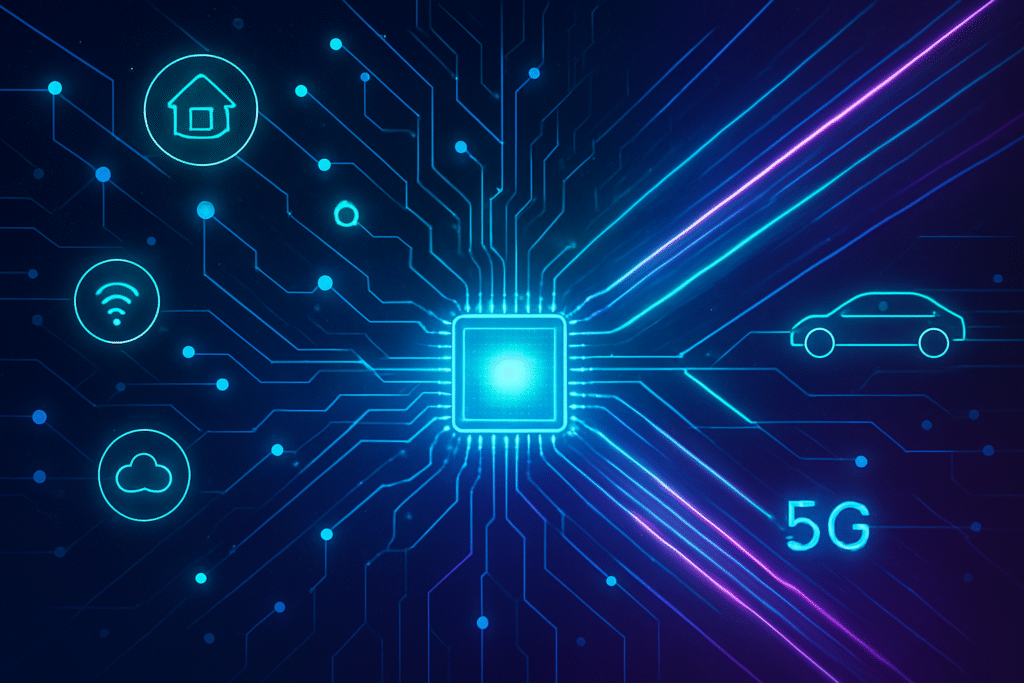
In an era increasingly defined by artificial intelligence, the unsung heroes powering the next wave of technological revolution are semiconductors. These miniature marvels are not only the lifeblood of AI but are also the crucial enablers for a myriad of emerging technologies such as the Internet of Things (IoT), 5G connectivity, and autonomous vehicles. Far from being disparate fields, these interconnected domains are locked in a symbiotic relationship, where advancements in one directly fuel innovation in the others, all underpinned by the relentless evolution of silicon. The immediate significance of semiconductors lies in their indispensable role in providing the core functionalities, processing capabilities, and seamless communication necessary for these transformative technologies to operate, integrate, and redefine our digital and physical landscapes.
The immediate impact of this semiconductor-driven convergence is profound. For IoT, semiconductors are the "invisible driving force" behind the vast network of smart devices, enabling everything from real-time data acquisition via sophisticated sensors to efficient on-device processing and robust connectivity. In the realm of 5G, these chips are the architects of ultra-fast speeds, ultra-low latency, and massive device connectivity, translating theoretical promises into tangible network performance. Meanwhile, autonomous vehicles, essentially "servers on wheels," rely on an intricate ecosystem of advanced semiconductors to perceive their environment, process vast amounts of sensor data, and make split-second, life-critical decisions. This interconnected dance of innovation, propelled by semiconductor breakthroughs, is rapidly ushering in an era of ubiquitous intelligence, where silicon-powered capabilities extend into nearly every facet of our daily existence.
Engineering the Future: Technical Advancements in Silicon for a Connected World
Semiconductor technology has undergone profound advancements to meet the rigorous and diverse demands of IoT devices, 5G infrastructure, and autonomous vehicles. These innovations represent a significant departure from previous generations, driven by the critical need for enhanced performance, energy efficiency, and highly specialized functionalities. For the Internet of Things, the focus has been on enabling ubiquitous connectivity and intelligent edge processing within severe constraints of power and size. Modern IoT semiconductors are characterized by ultra-low-power microcontroller (MCU)-based System-on-Chips (SoCs), implementing innovative power-saving methods to extend battery life. There's also a strong trend towards miniaturization, with chip sizes aiming for 3nm and 2nm processes, allowing for smaller, more integrated chips and compact SoC designs that combine processors, memory, and communication components into a single package. Chiplet-based architectures are also gaining traction, offering flexibility and reduced production costs for diverse IoT devices.
5G technology, on the other hand, demands semiconductors capable of handling unprecedented data speeds, high frequencies, and extremely low latency for both network infrastructure and edge devices. To meet 5G's high-frequency demands, particularly for millimeter-wave signals, there's a significant adoption of advanced materials like gallium nitride (GaN) and silicon carbide (SiC). These wide-bandgap (WBG) materials offer superior power handling, efficiency, and thermal management compared to traditional silicon, making them ideal for high-frequency, high-power 5G applications. The integration of Artificial Intelligence (AI) into 5G semiconductors allows for dynamic network traffic management, reducing congestion and enhancing network efficiency and lower latency, while advanced packaging technologies reduce signal travel time.
Autonomous vehicles are essentially "servers on wheels," requiring immense computational power, specialized AI processing, and robust safety mechanisms. This necessitates advanced chipsets designed to process terabytes of data in real-time from various sensors (cameras, LiDAR, radar, ultrasonic) to enable perception, planning, and decision-making. Specialized AI-powered chips, such as dedicated Neural Processing Units (NPUs), Graphics Processing Units (GPUs), and Application-Specific Integrated Circuits (ASICs), are essential for handling machine learning algorithms. Furthermore, semiconductors form the backbone of Advanced Driver-Assistance Systems (ADAS), powering features like adaptive cruise control and automatic emergency braking, providing faster processing speeds, improved sensor fusion, and lower latency, all while adhering to stringent Automotive Safety Integrity Level (ASIL) requirements. The tech community views these advancements as transformative, with AI-driven chip designs hailed as an "indispensable tool" and "game-changer," though concerns about supply chain vulnerabilities and a global talent shortage persist.
Corporate Chessboard: How Semiconductor Innovation Reshapes the Tech Landscape
The increasing demand for semiconductors in IoT, 5G, and autonomous vehicles is poised to significantly benefit several major semiconductor companies and tech giants, while also fostering competitive implications and strategic advantages. The global semiconductor market is projected to exceed US$1 trillion by the end of the decade, largely driven by these burgeoning applications. Companies like NVIDIA (NASDAQ: NVDA) are at the forefront, leveraging their leadership in high-performance GPUs, critical for AI model training and inferencing in autonomous vehicles and cloud AI. Qualcomm (NASDAQ: QCOM) is strategically diversifying beyond smartphones, aiming for substantial annual revenue from IoT and automotive sectors by 2029, with its Snapdragon Digital Chassis platform supporting advanced vehicle systems and its expertise in edge AI for IoT.
TSMC (NYSE: TSM), as the world's largest contract chip manufacturer, remains an indispensable player, holding over 90% market share in advanced chip manufacturing. Its cutting-edge fabrication technologies are essential for powering AI accelerators from NVIDIA and Google's TPUs, as well as chips for 5G communications, IoT, and automotive electronics. Intel (NASDAQ: INTC) is developing powerful SoCs for autonomous vehicles and expanding collaborations with cloud providers like Amazon Web Services (AWS) to accelerate AI workloads. Samsung (KRX: 005930) has a comprehensive semiconductor strategy, planning mass production of advanced process technologies by 2025 and aiming for high-performance computing, automotive, 5G, and IoT to make up over half of its foundry business. Notably, Tesla (NASDAQ: TSLA) has partnered with Samsung to produce its next-gen AI inference chips, diversifying its supply chain and accelerating its Full Self-Driving capabilities.
Tech giants are also making strategic moves. Google (NASDAQ: GOOGL) invests in custom AI chips like Tensor Processing Units (TPUs) for cloud AI, benefiting from the massive data processing needs of IoT and autonomous vehicles. Amazon (NASDAQ: AMZN), through AWS, designs custom silicon optimized for the cloud, including processors and machine learning chips, further strengthening its position in powering AI workloads. Apple (NASDAQ: AAPL) leverages its aggressive custom silicon strategy, with its A-series and M-series chips, to gain significant control over hardware and software integration, enabling powerful and efficient AI experiences on devices. The competitive landscape is marked by a trend towards vertical integration, with tech giants increasingly designing their own custom chips, creating both disruption for traditional component sellers and opportunities for leading foundries. The focus on edge AI, specialized chips, and new materials also creates avenues for innovation, while ongoing supply chain vulnerabilities push for greater resilience and diversification.
Beyond the Horizon: Societal Impact and Broader Significance
The current wave of semiconductor innovation, particularly its impact on IoT, 5G, and autonomous vehicles, extends far beyond technological advancements, profoundly reshaping the broader societal landscape. This evolution fits into the technological tapestry as a cornerstone of smart cities and Industry 4.0, where interconnected IoT devices feed massive amounts of data into 5G networks, enabling real-time analytics and control for optimized industrial processes and responsive urban environments. This era, often termed "ubiquitous intelligence," sees silicon intelligence becoming foundational to daily existence, extending beyond traditional computing to virtually every aspect of life. The demand for specialized chips, new materials, and advanced integration techniques is pushing the boundaries of what's possible, creating new markets and establishing semiconductors as critical strategic assets.
The societal impacts are multifaceted. Economically, the semiconductor industry is experiencing massive growth, with the automotive semiconductor market alone projected to reach $129 billion by 2030, driven by AI-enabled computing. This fosters economic growth, spurs innovation, and boosts operational efficiency across industries. Enhanced safety and quality of life are also significant benefits, with autonomous vehicles promising safer roads by reducing human error, and IoT in healthcare offering improved patient care and AI-driven diagnostics. However, concerns about job displacement in sectors like transportation due to autonomous vehicles are also prevalent.
Alongside the benefits, significant concerns arise. The semiconductor supply chain is highly complex and geographically concentrated, creating vulnerabilities to disruptions and geopolitical risks, as evidenced by recent chip shortages. Cybersecurity is another critical concern; the pervasive deployment of IoT devices, connected 5G networks, and autonomous vehicles vastly expands the attack surface for cyber threats, necessitating robust security features in chips and systems. Ethical AI in autonomous systems presents complex dilemmas, such as the "trolley problem" for self-driving cars, raising questions about accountability, responsibility, and potential biases in AI algorithms. This current wave of innovation is comparable to previous technological milestones, such as the mainframe and personal computing eras, but is distinguished by its sustained, exponential growth across multiple sectors and a heightened focus on integration, specialization, and societal responsibility, including the environmental footprint of hardware.
The Road Ahead: Future Developments and Expert Predictions
The future of semiconductors is intrinsically linked to the continued advancements in the Internet of Things, 5G connectivity, and autonomous vehicles. In the near term (1-5 years), we can expect an increased integration of specialized AI chips optimized for edge computing, crucial for real-time processing directly on devices like autonomous vehicles and intelligent IoT sensors. Wide Bandgap (WBG) semiconductors, such as Silicon Carbide (SiC) and Gallium Nitride (GaN), will continue to replace traditional silicon in power electronics, particularly for Electric Vehicles (EVs), offering superior efficiency and thermal management. Advancements in high-resolution imaging radar and LiDAR sensors, along with ultra-low-power SoCs for IoT, will also be critical. Advanced packaging technologies like 2.5D and 3D semiconductor packaging will become more prevalent to enhance thermal management and support miniaturization.
Looking further ahead (beyond 5 years), breakthroughs are anticipated in energy harvesting technologies to autonomously power IoT devices in remote environments. Next-generation memory technologies will be crucial for higher storage density and faster data access, supporting the increasing data throughput demands of mobility and IoT devices. As 6G networks emerge, they will demand ultra-fast, low-latency communication, necessitating advanced radio frequency (RF) components. Neuromorphic computing, designing chips that mimic the human brain for more efficient processing, holds immense promise for substantial improvements in energy efficiency and computational power. While still nascent, quantum computing, heavily reliant on semiconductor advancements, offers unparalleled long-term opportunities to revolutionize data processing and security within these ecosystems.
These developments will unlock a wide array of transformative applications. Fully autonomous driving (Level 4 & 5) is expected to reshape urban mobility and logistics, with robo-taxis scaling by around 2030. Enhanced EV performance, intelligent transportation systems, and AI-driven predictive maintenance will become standard. In IoT, smarter cities and advanced healthcare will benefit from pervasive smart sensors and edge AI, including the integration of genomics into portable semiconductor platforms. 5G and beyond (6G) will provide ultra-reliable, low-latency communication essential for critical applications and support massive machine-type communications for countless IoT devices. However, significant challenges remain, including further advancements in materials science, ensuring energy efficiency in high-performance chips, integrating quantum computing, managing high manufacturing costs, building supply chain resilience, mitigating cybersecurity risks, and addressing a deepening global talent shortage in the semiconductor industry. Experts predict robust growth for the automotive semiconductor market, a shift towards software-defined vehicles, and intensifying strategic partnerships and in-house chip design by automakers. The quantum computing industry is also projected for significant growth, with its foundational impact on underlying computational power being immense.
A New Era of Intelligence: The Enduring Legacy of Semiconductor Innovation
The profound and ever-expanding role of semiconductors in the Internet of Things, 5G connectivity, and autonomous vehicles underscores their foundational importance in shaping our technological future. These miniature marvels are not merely components but are the strategic enablers driving an era of unprecedented intelligence and connectivity. The symbiotic relationship between semiconductor innovation and these emerging technologies creates a powerful feedback loop: advancements in silicon enable more sophisticated IoT devices, faster 5G networks, and smarter autonomous vehicles, which in turn demand even more advanced and specialized semiconductors. This dynamic fuels exponential growth and constant innovation in chip design, materials science, and manufacturing processes, leading to faster, cheaper, lower-power, and more durable chips.
This technological shift represents a transformative period, comparable to past industrial revolutions. Just as steam power, electricity, and early computing reshaped society, the pervasive integration of advanced semiconductors with AI, 5G, and IoT marks a "transformative era" that will redefine economies and daily life for decades to come. It signifies a tangible shift from theoretical AI to practical, real-world applications directly influencing our daily experiences, promising safer roads, optimized industrial processes, smarter cities, and more responsive environments. The long-term impact is poised to be immense, fostering economic growth, enhancing safety, and improving quality of life, while also presenting critical challenges that demand collaborative efforts from industry, academia, and policymakers.
In the coming weeks and months, critical developments to watch include the continued evolution of advanced packaging technologies like 3D stacking and chiplets, the expanding adoption of next-generation materials such as GaN and SiC, and breakthroughs in specialized AI accelerators and neuromorphic chips for edge computing. The integration of AI with 5G and future 6G networks will further enhance connectivity and unlock new applications. Furthermore, ongoing efforts to build supply chain resilience, address geopolitical factors, and enhance security will remain paramount. As the semiconductor industry navigates these complexities, its relentless pursuit of efficiency, miniaturization, and specialized functionality will continue to power the intelligent, connected, and autonomous systems that define our future.
This content is intended for informational purposes only and represents analysis of current AI developments.
TokenRing AI delivers enterprise-grade solutions for multi-agent AI workflow orchestration, AI-powered development tools, and seamless remote collaboration platforms.
For more information, visit https://www.tokenring.ai/.






